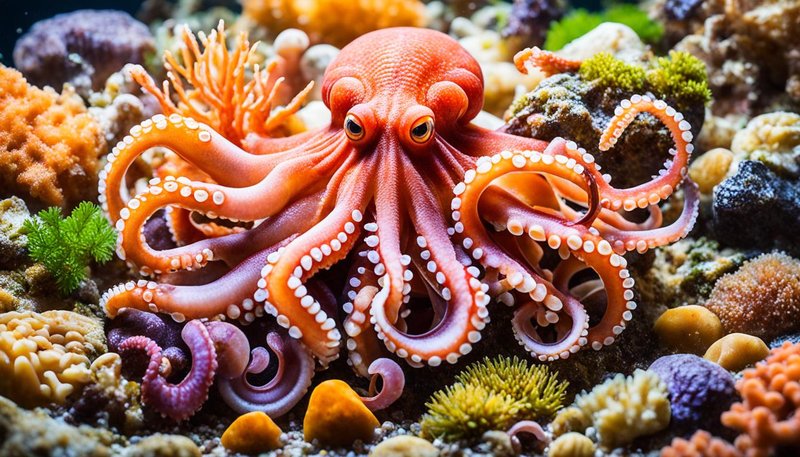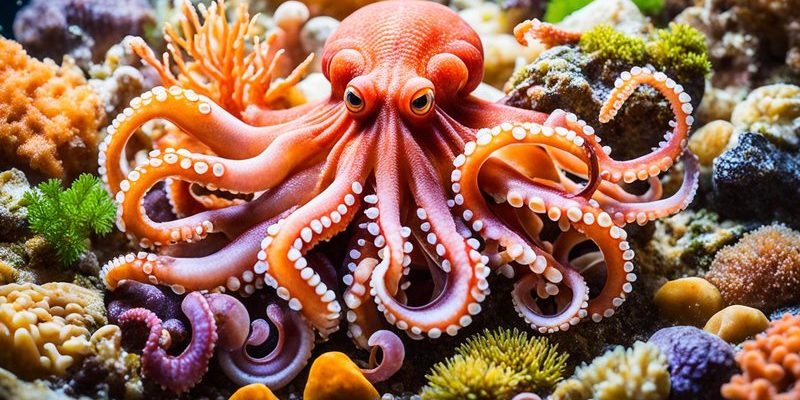
The giant Pacific octopus can weigh over 100 pounds and measure up to 16 feet across, making it one of the largest octopus species. Its size and incredible adaptability give it a robust menu rich in variety. From crabs to fish, the octopus is a skilled predator. But how do these creatures hunt their prey? You might be surprised to learn that they use a mix of stealth, skill, and even tools to catch their meals. So, grab your favorite drink, and let’s explore the fascinating world of what the giant Pacific octopus eats and how it goes about finding its food.
What Does the Giant Pacific Octopus Eat?
The giant Pacific octopus has a diverse diet that mainly consists of various marine animals. You might be wondering, “What exactly are these creatures munching on?” The octopus has a real knack for selecting its meals, which include:
- Crustaceans: Crabs, shrimp, and lobsters are among the octopus’s favorite snacks.
- Fish: Small fish species, like herring and rockfish, are also part of their diet.
- Mollusks: They enjoy other mollusks, such as clams and snails.
This diverse menu is essential for the octopus’s survival. Each of these food sources provides critical nutrients and energy needed to thrive. Honestly, they’re like the ultimate foodies of the ocean, taking advantage of whatever is available in their habitat.
How Do Giant Pacific Octopuses Hunt?
Let me explain how the giant Pacific octopus goes about securing its meals. Hunting isn’t just about being fast; it’s also about being smart. These octopuses use a combination of stealth, agility, and, interestingly enough, their environment to capture prey.
First off, they are masters of camouflage. Their ability to change color and texture allows them to blend into their surroundings. Imagine trying to hunt while dressed as your environment—pretty neat, right? When a giant Pacific octopus spots a crab or a fish, it patiently waits, often hiding within rocks or coral, ready to strike.
Once within striking distance, the octopus uses its long arms, equipped with sensitive suckers, to grasp and capture its prey. The suckers can grip firmly, thanks to their ability to create suction. It’s like having a set of super strong fingers! After capturing its meal, the octopus uses its beak—similar to a bird’s—to break through shells and access the soft flesh inside. Talk about a versatile tool set!
The Role of Intelligence in Feeding
Here’s the thing: intelligence plays a massive role in how giant Pacific octopuses find and catch their food. These creatures are known for their problem-solving abilities. You may not realize it, but they can even figure out how to manipulate objects to get to their prey.
For example, there have been instances where octopuses have been observed using removable shells or dislodging rocks to access harder-to-reach prey. This behavior demonstrates their ability to think critically about their hunting strategies. If you’ve ever enjoyed a challenging puzzle, you can relate to the satisfaction these octopuses must feel when outsmarting their prey.
Additionally, octopuses are known to explore their environment. They’ll search through underwater nooks and crannies to find hiding spots where prey may be lurking. It’s almost like they’re going grocery shopping, seeking the best items on sale!
Feeding Frequency and Habits
You might wonder how often giant Pacific octopuses eat. Well, the frequency of their meals can vary based on age, size, and availability of food. Generally, an adult giant Pacific octopus typically eats between two to three times a week. Here’s a fun fact: they have a very high metabolism, which means they need to consume a lot of food.
When they do eat, you’ll find them feasting on larger quantities—often consuming about 10% of their body weight in a single meal! So, if you can imagine a meal that weighs as much as a small dog, you’re on the right track. After a hearty meal, they may not need to hunt again for several days, thanks to their effective eating habits.
Also, it’s interesting to note that feeding behavior can change with different life stages. For younger octopuses, smaller prey like shrimp and small fish are more common, while adults tend to go for larger, more robust meals. This evolutionary strategy helps ensure they mature into strong, healthy adults.
Feeding Strategies: Night vs. Day
Another cool aspect of the giant Pacific octopus’s feeding habits is how they adapt based on the time of day. 🦑 While these octopuses are primarily nocturnal hunters, they can also be spotted feeding during daylight hours.
At night, they come alive, thanks to the darkness providing cover from predators. Imagine the thrill of exploring under the moonlight, where you can sneak up on your dinner without being seen! During this time, they hunt more actively, using their camouflage to ambush unsuspecting prey.
During the day, they may be less active, retreating to hiding spots like caves or crevices. However, if they’re hungry enough, they won’t hesitate to emerge to grab a meal. Their flexible feeding strategy allows them to take advantage of whatever opportunities arise, which is a smart way to survive in the wild.
Impact of Environment on Feeding
The habitat of the giant Pacific octopus significantly impacts its feeding habits. These creatures inhabit various environments, from rocky shorelines to deep-sea reefs, and what’s available in their surroundings plays a huge role in what they eat.
For instance, in areas with lots of crabs and shellfish, you’ll find octopuses indulging in those delicacies. Alternatively, in regions teeming with fish, they’ll adapt their hunting methods to catch more fish. The ability to adjust their diet based on what’s around them shows just how adaptive and resourceful these animals are.
Moreover, the health of their environment is crucial. If pollution or overfishing occurs in their region, it could impact their food sources. This ripple effect can lead to changes in feeding behaviors and even population dynamics. When you think about it, maintaining a healthy ocean is vital not just for octopuses but for the entire ecosystem.
The giant Pacific octopus is truly a marvel of nature. Its diet and feeding habits showcase not just its role as a predator but also its incredible adaptability and intelligence. By understanding what these amazing creatures eat and how they hunt, we gain a deeper appreciation for the complex web of life beneath the ocean’s surface.
As we continue to explore the world’s oceans, let’s remember the importance of preserving the habitats of these remarkable octopuses and their prey. By protecting their environment, we ensure that future generations can continue to marvel at the giant Pacific octopus and its extraordinary feeding habits.

